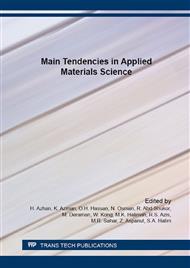[1]
K. Kumar, S. B. Rai, A. Rai, Strong Blue Emission from Pr3+ Ions Through Energy Transfer Process from Nd3+ To Pr3+ via Yb3+ in Tellurite Glass, Spectrochimica Acta Part A 71 (2008) 508 – 512.
DOI: 10.1016/j.saa.2007.12.043
Google Scholar
[2]
G. Lakshminarayana, J. Qiu, M. G. Brik, G. A. Kumar, I. V. Kityk, Spectra analysis of RE3+ (RE = Er, Nd, Pr and Ho): GeO2 – B2O3 – ZnO – LiF Glasses, J. Phys. Condens. Matter 20 (2008) 375104 (12pp).
DOI: 10.1088/0953-8984/20/37/375104
Google Scholar
[3]
G. Lakshminarayana, R. V. Sagar, S. Buddhudu, NIR Luminescence from Er3+ / Yb3+, Er3+ / Yb3+, Er3+ / Yb3+ and Er3+ ions- doped Zincborotellurite glasses for optical amplification, J. Luminescence 128 (2008) 690 – 695.
DOI: 10.1016/j.jlumin.2007.11.081
Google Scholar
[4]
Y. Wang, S. Dai, F. Chen, T. Xu, Q. Nie, Physical Properties and Optical Band Gap of New Tellurite Glasses Within the TeO2 – Nb2O5 – Bi2O3System, Materials Chemistry& Physics 113 (2009) 407 – 411.
DOI: 10.1016/j.matchemphys.2008.07.117
Google Scholar
[5]
I. Z. Hager, R. El-Mallawany, A. Bulou, Luminescence Spectra and Optical Properties of TeO2- WO3- Li2O Glasses doped with Nd, Sm and Er Rare Earth Ions, Physica B 406 (2011) 972 – 980.
DOI: 10.1016/j.physb.2010.12.041
Google Scholar
[6]
M. D. Reza, M.R. Sahar, S.K. Ghoshal, R.J. Amjad, A.R. Samavati, Effect of AgCl on Spectroscopic Properties of Erbium doped Zinc Tellurite Glass, Journal of Molecular Structure 1035 (2013) 6 – 12.
DOI: 10.1016/j.molstruc.2012.09.023
Google Scholar
[7]
M. Sobczyk, Temperature Dependent Luminescence and Temperature Stimulated NIR to Vis Upconversion in Nd3+ doped La2O3 – Na2O – ZnO – TeO2 Glasses, Journal of Quantitative Spectroscopy & Radiative Transfer (2013).
DOI: 10.1016/j.jqsrt.2012.12.025
Google Scholar
[8]
K. Azman, Neodymium/ Erbium Codoped Tellurite Glass System, (2010) PhD Thesis UTM.
Google Scholar
[9]
R. El- Mallawany, M.D. Abdalla, I.A. Ahmed, New Tellurite Glass: Optical Properties, Materials Chemistry and Physics 109 (2008) 291 – 296.
DOI: 10.1016/j.matchemphys.2007.11.040
Google Scholar
[10]
S. Xiang, N. Qiuhua, X. Tiefeng, D. Shixun,W. Xunsi, Investigation on energy transfer from Er3+ to Nd3+ in tellurite glass, Journal of Rare Earths 26 (2008) 899- 903.
DOI: 10.1016/s1002-0721(09)60029-6
Google Scholar
[11]
A.D. Sontakke, K. Biswas, A.K. Mandal, K. Annapurna, Time resolved fluorescence and energy transfer analysis of Nd3+-Yb3+-Er3+ triply-doped Ba-Al-metaphosphate glasses for an eye safe emission (1. 54 μm), Journal of Fluorescence 20 (2010).
DOI: 10.1007/s10895-009-0562-z
Google Scholar
[12]
N. Fakhra, M.R. Sahar, S.K. Ghoshal, R.J. Amjad, M.R. Dousti, A. Asmahani, Spectral Investigation of Sm3+ / Yb3+ co-doped Sodium Tellurite Glass, Chinese Optics Letters 11(6) (2013) 061605.
DOI: 10.3788/col201311.061605
Google Scholar
[13]
P.V. Ramakrishna, S.V.N. Pammi, K. Samatha, UV – Visible Upconversion Studies of Nd3+ Ions in Tellurite Glass, Solid State Communications 155 (2013) 21 – 24.
DOI: 10.1016/j.ssc.2012.10.043
Google Scholar
[14]
S. Zheng, Y. Zhou, D. Yin, X. Xu, Y. Qi, S. Peng, The 1. 53 μm Spectroscopic Properties and Thermal Stability in Er3+/ Ce3+ codoped TeO2 – WO3 – Na2O – Nb2O5 Glasses, Journal of Quantitative Spectroscopy & Radiative Transfer 120 (2013) 44 –51.
DOI: 10.1016/j.jqsrt.2013.02.024
Google Scholar
[15]
K. Azman, Absorption and Upconversion of (Nd3+/ Er3+) doped Tellurite Glass, IEEE Business, Engineering & Industrial Applications Colloquium (2012) 38 – 42.
Google Scholar
[16]
L. Jyothi, V. Venkatramu, P. Babu, C.K. Jayasankar, M. Benttinelli, G. Mariotto, A. Speghini, Composition and Concentration Dependence of Spectroscopic Properties of Nd3+ doped Tellurite and Metaborate Glasses, Optical Materials 33 (2011).
DOI: 10.1016/j.optmat.2010.11.015
Google Scholar
[17]
K. Selvaraju, K. Marimuthu, Structural and Spectroscopic Studies on Concentration Dependent Sm3+ doped Boro – Tellurite Glasses, Journal of Alloys & Compounds 553 (2013) 273 – 281.
DOI: 10.1016/j.jallcom.2012.11.150
Google Scholar


